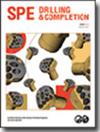Experimental Investigation of Aloe-Vera-Based CuO Nanofluid as a Novel Additive in Improving the Rheological and Filtration Properties of Water-Based Drilling Fluid
IF 1.2
4区 工程技术
Q3 ENGINEERING, PETROLEUM
引用次数: 7
Abstract
Drilling technology in petroleum engineering is associated with problems such as high fluid loss, poor hole cleaning, and pipe sticking. Improvement of rheological and filtration properties of water-based drilling fluids (WDFs) plays a major role in resolving these drilling problems. The application of nanotechnology to WDF in the recent past has attracted much attention in addressing these drilling operations problems. In the present work, we investigate the application of natural aloe vera and CuO nanofluids combined as an additive in WDF to address the drilling problems. The nanofluids of three different concentrations of CuO nanoparticle (0.2, 0.4 , and 0.6 wt%) with aloe vera as a base fluid are prepared for this study by adopting a two-step method. The prepared nanofluids are characterized by their particle size and morphological characteristics. Conventional WDF (DF.0) is synthesized, and the prepared aloe-vera-based CuO nanofluid is added to the WDF to prepare nanofluid-enhancedwater-based drilling fluid (NFWDF) of different concentrations of nanoparticles, namely, 0.2 , 0.4, and 0.6 wt%. The prepared drilling fluid mixture is then characterized for its rheological and filtrate loss properties at various temperatures. Thermal stability and aging studies are performed for both WDF and NFWDF. The experimental results are then modeled using rheological models. The results reveal that aloe-vera-based CuO nanofluids improve the thermal stability and rheological properties of drilling fluid and significantly decrease the American Petroleum Institute (API) filtrate. Viscosity for WDF shows an approximately 61.7% decrease in heating up to 90°C. Further, the hot roll aging test causes a 63% decrease in the viscosity of WDF at 90°C. However, the addition of aloe-vera-based CuO nanofluids is found to aid in recovering the viscosities to a great extent. The fluid loss values before hot rolling are observed to be 6.6 mL after 30 minutes, whereas fluid loss values for the NFWDFs are found to be 5.9, 5.4, and 4.6 mL, respectively. The fluid loss value after hot rolling for the WDF is found to be 10.8 mL after 30 minutes, whereas fluid loss values for the NFWDFs are found to be 9.2, 8.5, and 7.7 mL, respectively. The rheological performance data of NFWDF project a better fit with the Herschel-Bulkley model and suggest improvement in rheological and filtration properties. There has been limited research work available in understanding the impact of aloe-vera-gel-based nanofluids in improving the performance of WDFs through the improvement of its rheological and filtration properties. This study aims to exploit the property of native aloe vera and CuO nanofluids combined together to enhance the rheological and filtration properties of WDF by conducting the tests both before and after hot rolling conditions. This study acts as an important precursor for developing novel additives for WDF to improve its rheological and filtration properties. This study is also expected to benefit the industry and solve the major challenges in deep-well drilling operations and high-pressure and high-temperature (HPHT) drilling operations.芦荟-维拉基CuO纳米流体作为新型添加剂改善水基钻井液流变和过滤性能的实验研究
在石油工程中,钻井技术存在着滤失大、井眼清洁差、钻杆卡钻等问题。改善水基钻井液的流变性和滤失性是解决这些钻井问题的重要途径。近年来,纳米技术在WDF中的应用引起了人们的广泛关注,以解决这些钻井作业问题。在本工作中,我们研究了天然芦荟和氧化铜纳米流体作为WDF添加剂的应用,以解决钻井问题。采用两步法制备了三种不同浓度的CuO纳米颗粒(0.2、0.4和0.6 wt%)的纳米流体,以芦荟为基液。所制备的纳米流体具有粒径和形态特征。合成常规WDF (DF.0),将制备好的芦荟基CuO纳米流体加入WDF中,制备出不同浓度的纳米流体增强水基钻井液(NFWDF),分别为0.2、0.4和0.6 wt%。然后表征所制备的钻井液混合物在不同温度下的流变性和滤失性。对WDF和NFWDF进行了热稳定性和老化研究。然后用流变模型对实验结果进行建模。结果表明,芦荟基CuO纳米流体改善了钻井液的热稳定性和流变性能,显著降低了美国石油协会(API)的滤液。WDF的粘度在加热到90°C时下降约61.7%。此外,热轧老化试验导致WDF在90℃时粘度下降63%。然而,芦荟基CuO纳米流体的添加被发现在很大程度上有助于恢复粘度。30分钟后观察到热轧前的液体损失量为6.6 mL,而nfwdf的液体损失量分别为5.9、5.4和4.6 mL。热轧30分钟后,WDF的失水值为10.8 mL,而nfwdf的失水值分别为9.2、8.5和7.7 mL。NFWDF项目的流变性能数据更符合Herschel-Bulkley模型,表明其流变性能和过滤性能有所改善。在了解芦荟凝胶基纳米流体通过改善其流变学和过滤性能来改善WDFs性能的影响方面,现有的研究工作有限。本研究旨在通过热轧前后的试验,利用天然芦荟和CuO纳米流体的特性来增强WDF的流变学和过滤性能。该研究为开发新型WDF添加剂以改善其流变性能和过滤性能提供了重要的先导。该研究也有望使行业受益,并解决深井钻井作业和高压高温(HPHT)钻井作业中的主要挑战。
本文章由计算机程序翻译,如有差异,请以英文原文为准。
求助全文
约1分钟内获得全文
求助全文
来源期刊

SPE Drilling & Completion
工程技术-工程:石油
CiteScore
4.20
自引率
7.10%
发文量
29
审稿时长
6-12 weeks
期刊介绍:
Covers horizontal and directional drilling, drilling fluids, bit technology, sand control, perforating, cementing, well control, completions and drilling operations.
 求助内容:
求助内容: 应助结果提醒方式:
应助结果提醒方式:


